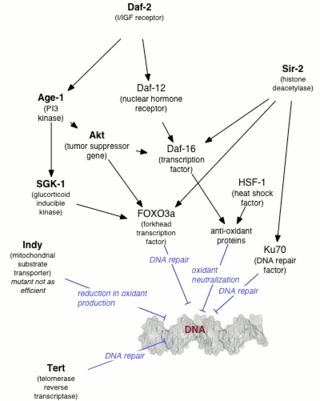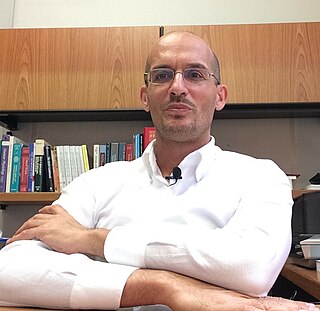Related Research Articles
Senescence or biological aging is the gradual deterioration of functional characteristics in living organisms. Whole organism senescence involves an increase in death rates or a decrease in fecundity with increasing age, at least in the later part of an organism's life cycle. However, the resulting effects of senescence can be delayed. The 1934 discovery that calorie restriction can extend lifespans by 50% in rats, the existence of species having negligible senescence, and the existence of potentially immortal organisms such as members of the genus Hydra have motivated research into delaying senescence and thus age-related diseases. Rare human mutations can cause accelerated aging diseases.

Life extension is the concept of extending the human lifespan, either modestly through improvements in medicine or dramatically by increasing the maximum lifespan beyond its generally-settled biological limit of around 125 years. Several researchers in the area, along with "life extensionists", "immortalists", or "longevists", postulate that future breakthroughs in tissue rejuvenation, stem cells, regenerative medicine, molecular repair, gene therapy, pharmaceuticals, and organ replacement will eventually enable humans to have indefinite lifespans through complete rejuvenation to a healthy youthful condition (agerasia). The ethical ramifications, if life extension becomes a possibility, are debated by bioethicists.

Longevity may refer to especially long-lived members of a population, whereas life expectancy is defined statistically as the average number of years remaining at a given age. For example, a population's life expectancy at birth is the same as the average age at death for all people born in the same year.
Maximum life span is a measure of the maximum amount of time one or more members of a population have been observed to survive between birth and death. The term can also denote an estimate of the maximum amount of time that a member of a given species could survive between birth and death, provided circumstances that are optimal to that member's longevity.
A low-protein diet is a diet in which people decrease their intake of protein. A low-protein diet is used as a therapy for inherited metabolic disorders, such as phenylketonuria and homocystinuria, and can also be used to treat kidney or liver disease. Low protein consumption appears to reduce the risk of bone breakage, presumably through changes in calcium homeostasis. Consequently, there is no uniform definition of what constitutes low-protein, because the amount and composition of protein for an individual with phenylketonuria would differ substantially from one with homocystinuria or tyrosinemia.
Calorie restriction mimetics (CRM), also known as energy restriction mimetics, are a hypothetical class of dietary supplements or drug candidates that would, in principle, mimic the substantial anti-aging effects that calorie restriction (CR) has on many laboratory animals and humans. CR is defined as a reduction in calorie intake of 20% to 50% without incurring malnutrition or a reduction in essential nutrients. An effective CRM would alter the key metabolic pathways involved in the effects of CR itself, leading to preserved youthful health and longer lifespan without the need to reduce food intake. The term was coined by Lane, Ingram, Roth of the National Institute on Aging in a seminal 1998 paper in the Journal of Anti-Aging Medicine, the forerunner of Rejuvenation Research. A number of genes and pathways have been shown to be involved with the actions of CR in model organisms and these represent attractive targets for drug discovery and for developing CRM. However, no effective CRM have been identified to date.
Calorie restriction is a dietary regimen that reduces the energy intake from foods and beverages without incurring malnutrition. The possible effect of calorie restriction on body weight management, longevity, and aging-associated diseases has been an active area of research.
The CRON-diet is a nutrient-rich, reduced calorie diet developed by Roy Walford, Lisa Walford, and Brian M. Delaney. The CRON-diet involves calorie restriction in the hope that the practice will improve health and retard aging, while still attempting to provide the recommended daily amounts of various nutrients. Other names include CR-diet, Longevity diet, and Anti-Aging Plan. The Walfords and Delaney, among others, founded the CR Society International to promote the CRON-diet.
Enquiry into the evolution of ageing, or aging, aims to explain why a detrimental process such as ageing would evolve, and why there is so much variability in the lifespans of organisms. The classical theories of evolution suggest that environmental factors, such as predation, accidents, disease, and/or starvation, ensure that most organisms living in natural settings will not live until old age, and so there will be very little pressure to conserve genetic changes that increase longevity. Natural selection will instead strongly favor genes which ensure early maturation and rapid reproduction, and the selection for genetic traits which promote molecular and cellular self-maintenance will decline with age for most organisms.
Leonard Pershing Guarente is an American biologist best known for his research on life span extension in the budding yeast Saccharomyces cerevisiae, roundworms, and mice. He is a Novartis Professor of Biology at the Massachusetts Institute of Technology.

Sirtuin 1, also known as NAD-dependent deacetylase sirtuin-1, is a protein that in humans is encoded by the SIRT1 gene.
Stanley Fields is an American biologist best known for developing the yeast two hybrid method for identifying protein–protein interactions. He is currently a professor of Genome Sciences at the University of Washington and Howard Hughes Medical Institute Investigator, and previously served as chair of the Department of Genome Sciences.
In biology, energy homeostasis, or the homeostatic control of energy balance, is a biological process that involves the coordinated homeostatic regulation of food intake and energy expenditure. The human brain, particularly the hypothalamus, plays a central role in regulating energy homeostasis and generating the sense of hunger by integrating a number of biochemical signals that transmit information about energy balance. Fifty percent of the energy from glucose metabolism is immediately converted to heat.
Sirtuin-activating compounds (STAC) are chemical compounds having an effect on sirtuins, a group of enzymes that use NAD+ to remove acetyl groups from proteins. They are caloric restriction mimetic compounds that may be helpful in treating various aging-related diseases.
CALERIE is a trial currently underway in the U.S. to study the effects of prolonged calorie restriction on healthy human subjects.
The anti-aging movement is a social movement devoted to eliminating or reversing aging, or reducing the effects of it. A substantial portion of the attention of the movement is on the possibilities for life extension, but there is also interest in techniques such as cosmetic surgery which ameliorate the effects of aging rather than delay or defeat it.

Genetics of aging is generally concerned with life extension associated with genetic alterations, rather than with accelerated aging diseases leading to reduction in lifespan.

Luigi Fontana is a physician scientist who studies healthy longevity, with a focus on calorie restriction, endurance exercise and metabolism. He is the Leonard P Ullmann Chair in Translational Metabolic Health at the Charles Perkins Centre, where he directs the Charles Perkins Centre Royal Prince Alfred Clinic and the CPC RPA Health for Life Research, Educational and Clinical Program. He is also a professor of medicine and nutrition in the Faculty of Medicine and Health at the University of Sydney and a clinical academic in the Department of Endocrinology at the Royal Prince Alfred Hospital in Sydney, Australia. Fontana was a professor of medicine and co-director of the Healthy Longevity Program at Washington University School of Medicine.

The mitochondrial theory of ageing has two varieties: free radical and non-free radical. The first is one of the variants of the free radical theory of ageing. It was formulated by J. Miquel and colleagues in 1980 and was developed in the works of Linnane and coworkers (1989). The second was proposed by A. N. Lobachev in 1978.
This timeline lists notable events in the history of research into senescence or biological aging, including the research and development of life extension methods, brain aging delay methods and rejuvenation.
References
- ↑ "University of Wisconsin - Madison Institute on Aging, Madison, Wisconsin". aging.wisc.edu. Retrieved 12 August 2014.
- ↑ "| Department of Medicine". www.medicine.wisc.edu. Retrieved 2022-02-13.
- 1 2 "Rozalyn Anderson's Laboratory | University Of Wisconsin - Department of Medicine". medicine.wisc.edu. Retrieved 12 August 2014.
- ↑ "Meet Our Faculty and Staff" . Retrieved 2015-09-12.
- ↑ Anderson, Rozalyn M.; Bitterman, Kevin J.; Wood, Jason G.; Medvedik, Oliver; Cohen, Haim; Lin, Stephen S.; Manchester, Jill K.; Gordon, Jeffrey I.; Sinclair, David A. (2002-05-24). "Manipulation of a nuclear NAD+ salvage pathway delays aging without altering steady-state NAD+ levels". The Journal of Biological Chemistry. 277 (21): 18881–18890. doi: 10.1074/jbc.M111773200 . ISSN 0021-9258. PMC 3745358 . PMID 11884393.
- ↑ Anderson, Rozalyn M.; Bitterman, Kevin J.; Wood, Jason G.; Medvedik, Oliver; Sinclair, David A. (2003-05-08). "Nicotinamide and PNC1 govern lifespan extension by calorie restriction in Saccharomyces cerevisiae". Nature. 423 (6936): 181–185. Bibcode:2003Natur.423..181A. doi:10.1038/nature01578. ISSN 0028-0836. PMC 4802858 . PMID 12736687.
- ↑ Anderson, Rozalyn M.; Latorre-Esteves, Magda; Neves, Ana Rute; Lavu, Siva; Medvedik, Oliver; Taylor, Christopher; Howitz, Konrad T.; Santos, Helena; Sinclair, David A. (2003-12-19). "Yeast life-span extension by calorie restriction is independent of NAD fluctuation". Science. 302 (5653): 2124–2126. Bibcode:2003Sci...302.2124A. doi:10.1126/science.1088697. ISSN 1095-9203. PMC 4998187 . PMID 14605207.
- ↑ Colman RJ, Anderson RM, Johnson SC; et al. (2009). "Caloric restriction delays disease onset and mortality in rhesus monkeys". Science. 325 (5937): 201–4. Bibcode:2009Sci...325..201C. doi:10.1126/science.1173635. PMC 2812811 . PMID 19590001.
{{cite journal}}: CS1 maint: multiple names: authors list (link) - ↑ Colman RJ; Beasley TM; Kemnitz JW; Johnson SC; Weindruch R; Anderson RM (Apr 1, 2014). "Caloric restriction reduces age-related and all-cause mortality in rhesus monkeys". Nature Communications. 5: 3557. Bibcode:2014NatCo...5.3557C. doi:10.1038/ncomms4557. PMC 3988801 . PMID 24691430.
- ↑ Anderson, R. M.; Shanmuganayagam, D.; Weindruch, R. (2009). "Caloric Restriction and Aging: Studies in Mice and Monkeys". Toxicologic Pathology. 37 (1): 47–51. doi:10.1177/0192623308329476. PMC 3734859 . PMID 19075044.
- ↑ Rezzi, Serge; Martin, François-Pierre J.; Shanmuganayagam, Dhanansayan; Colman, Ricki J.; Nicholson, Jeremy K.; Weindruch, Richard (2009). "Metabolic shifts due to long-term caloric restriction revealed in nonhuman primates". Experimental Gerontology. 44 (5): 356–62. doi:10.1016/j.exger.2009.02.008. PMC 2822382 . PMID 19264119.
- ↑ "The New York Times". The New York Times . Retrieved 12 August 2014.
- ↑ "The New York Times". The New York Times . Retrieved 12 August 2014.
- ↑ Health, University of Wisconsin School of Medicine and Public. "UWSMPH". UW School of Medicine and Public Health. Retrieved 2015-09-12.
- ↑ Rogers, Anthony. "Awardees - Nathan Shock Award". prod.geron.org. Archived from the original on 2015-07-21. Retrieved 2015-09-12.
- ↑ "Previous Meetings". www.americanagingassociation.org. Retrieved 2022-02-13.
- ↑ "Oxford Journals | Medicine & Health & Science & Mathematics | The Journals of Gerontology: Series A | Editorial Board - Biological Sciences". www.oxfordjournals.org. Archived from the original on 2011-06-09. Retrieved 2015-09-12.